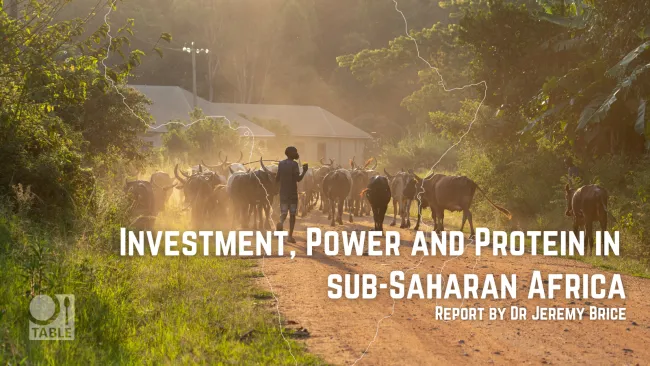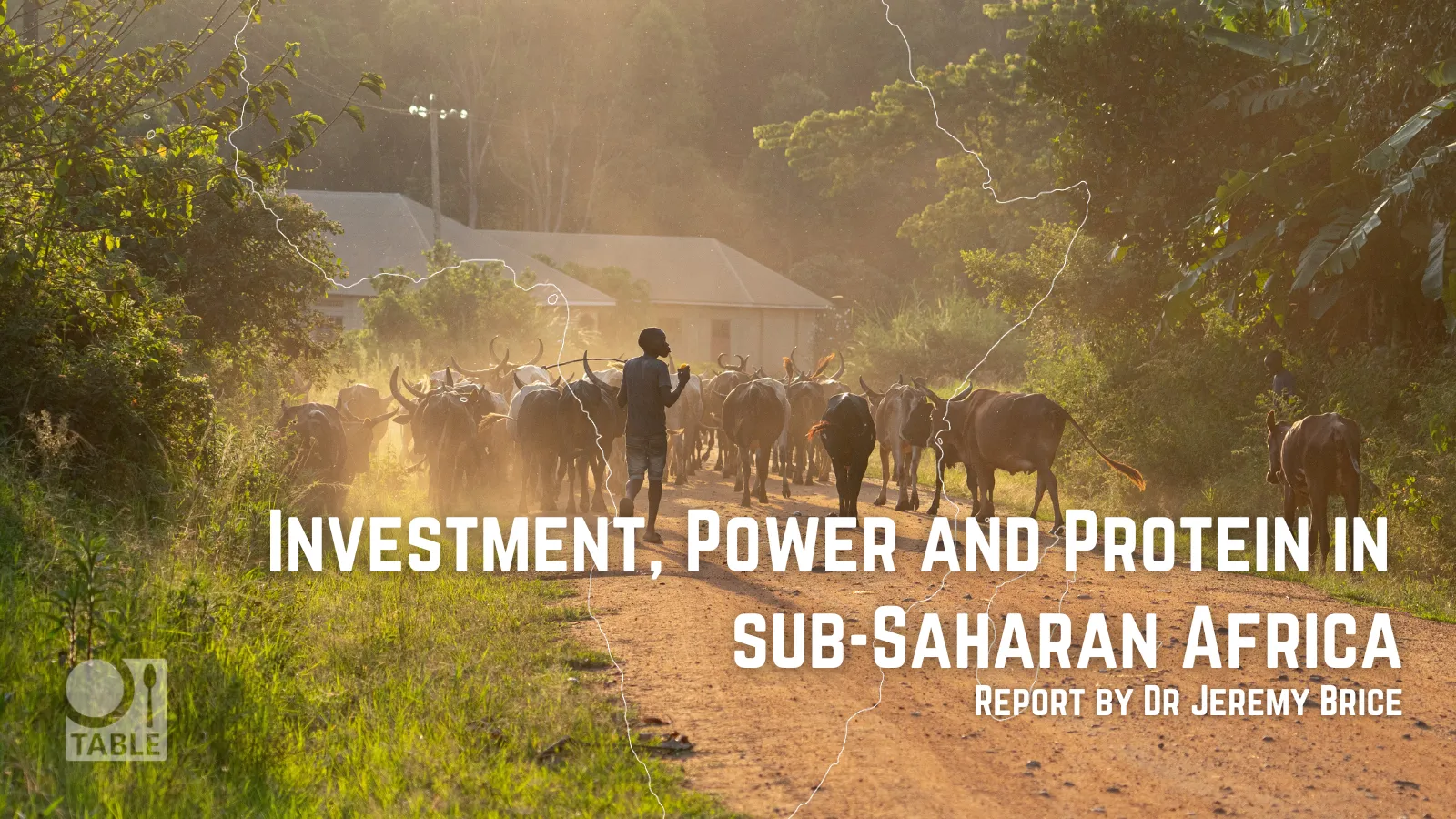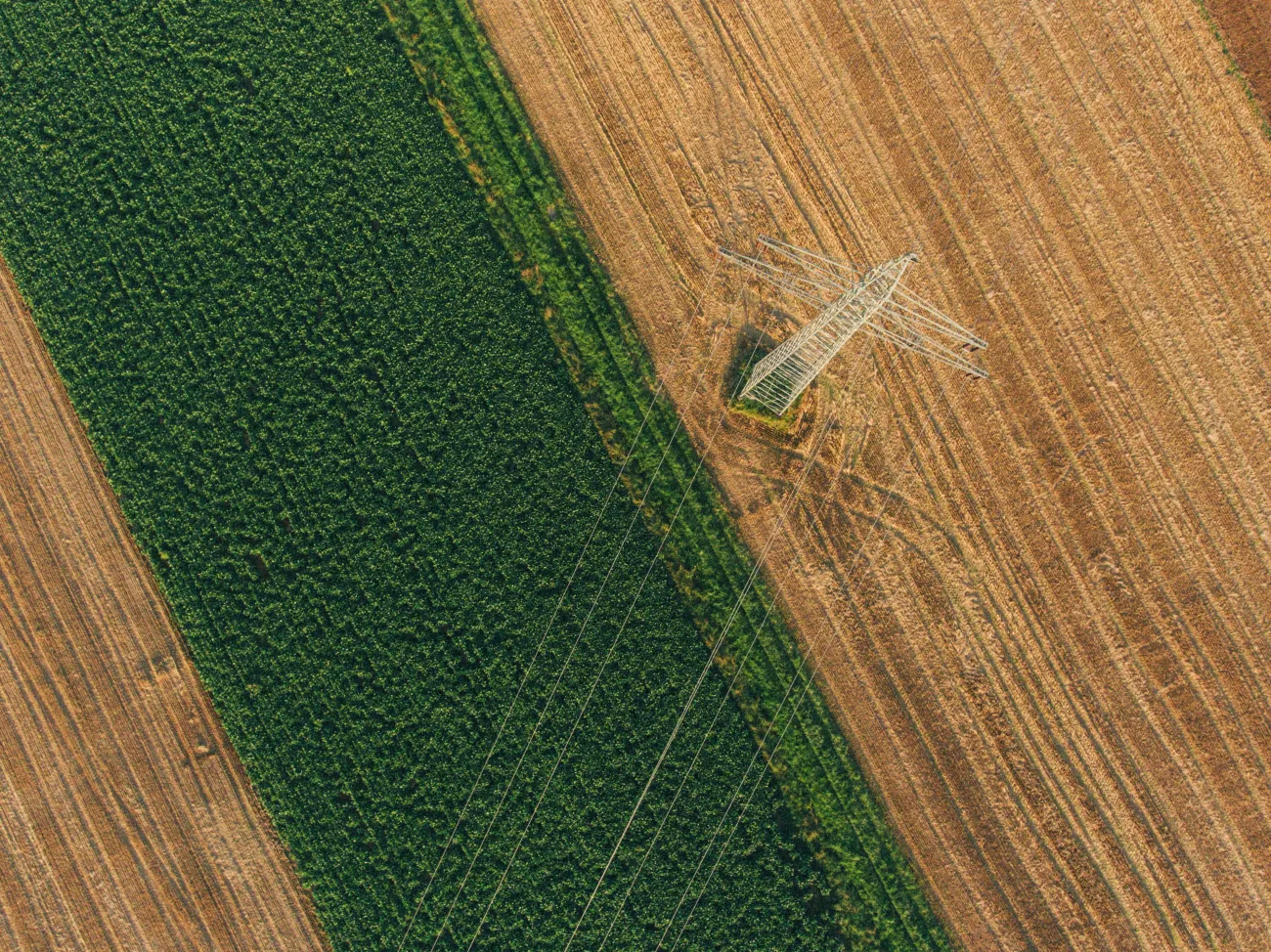Investment, Power and Protein in sub-Saharan Africa:
- Introduction
- Background
- Research Methodology
- Sub-Saharan Africa’s Agricultural Investment Landscape
- Investor Visions
- National Subsidies and Global Market
- Conclusions
- Glossary
Suggested citation:
Brice, J., (2022) Investment, Power and Protein in sub-Saharan Africa. TABLE Reports. TABLE, University of Oxford, Swedish University of Agricultural Sciences and Wageningen University and Research. doi.org/10.56661/d8817170
This report examines financial investment in protein production in sub-Saharan Africa. This includes investment in a) animal products such as meat, fish, eggs and dairy products; b) crops containing high concentrations of protein such as beans, pulses and legumes; and c) processed ‘alternative protein’ products whose ingredients are derived from plants, insects, micro-organisms or animal cells grown as part of a tissue culture. Through analysing investment by state, philanthropic and private sector organisations – as well as multilateral financial institutions such as development banks – it aims to establish which actors invest in various types of protein production in sub-Saharan Africa, and to investigate which protein sources and stages of the value chain they finance.
In so doing, the report explores what sorts of protein production and provisioning systems are being brought into being in sub-Saharan Africa using the funding provided by different groups of investors – and what alternative possibilities might be being marginalised due to a lack of investment. It thus seeks to understand what might be attracting investment to particular protein production systems, groups of enterprises and locations within sub-Saharan Africa, and whose priorities, preferences and visions for the future of food might be informing the changing place of protein in sub-Saharan African diets, economies and food systems.
This research forms part of TABLE’s work theme on “Power in the food system: what’s powering the future of protein?”, which uses protein as a case study through which to explore debates about power in the food system. This work theme examines governmental, geopolitical, and corporate power alongside the influence of its less tangible manifestations – such as cultural, moral, or educational norms – on how stakeholders think about food and what they want for the food system.
This project responds to the work theme’s priorities by examining what motivates the stakeholders who have the power to grant or deny finance to particular forms of protein production, and thus to shape sub-Saharan African food systems. To this end it investigates what values, visions and expectations about the future of food influence investors’ decisions about where to invest their capital.
This report begins by reviewing publicly available reports and statistics in order to assess which actors provide the largest quantities of finance to support protein production in sub-Saharan Africa. Based on the findings of this review, the author conducted nineteen expert interviews with representatives of organisations identified as key funders of protein production in sub-Saharan Africa and with other individuals who had longstanding professional links with important groups of investors. These interviews provided insight into the investment decision-making processes of key funders of protein production in this region and into the normative goals, values and expectations about the future of African diets and food systems which shaped their investment priorities. In so doing, they explored why the patterns of investment in protein production identified through the initial desk review had emerged and what sorts of future food systems they might be intended to create across sub-Saharan Africa. This research report aims to answer four questions:
- Who is currently investing in protein production in sub-Saharan Africa (including meat, egg and dairy production, aquaculture, the cultivation of protein crops such as legumes, animal feed production and alternative protein production)?
- What goals do these investors aim to achieve (or what sort of future do they seek to bring about) through making these investments?
- Which protein sources and protein production systems do they finance?
- What theory of change links their investment strategy to these goals?
Following this short introduction, Chapter 2 establishes the context for the research on which this report is based. It outlines the rationale for this report’s focus on protein, examines protein’s changing place in sub-Saharan African diets and food systems and introduces research which approaches these issues through the concept of ‘nutritional transitions’. Chapter 3 briefly describes the methodology of the research on which this report is based, while Chapter 4 presents the results of the desktop research conducted during the first phase of this project and identifies the major sources of investment in protein production in sub-Saharan Africa. Chapter 5 then presents the findings of interviews both with representatives of organisations which invest directly in protein production in sub-Saharan Africa and with other relevant experts. It identifies three distinct networks of investors, outlines the contrasting goals and values which shape each investor network’s decisions about which forms of protein production to finance, and discusses which countries, livestock species and sections of protein value chains form the focus of their investments. Chapter 6 sets the research presented in this report in the broader context of global flows of agricultural finance, and reflects on its limitations, through examining the role of government subsidies to livestock producers elsewhere in the world in shaping international trade in meat and dairy products and thus the development of sub-Saharan Africa’s food system. Finally, Chapter 7 provides a short conclusion which summarises the project’s main findings and outlines possible directions for future research.
< Previous: Title page Next: Background >





Comments (0)